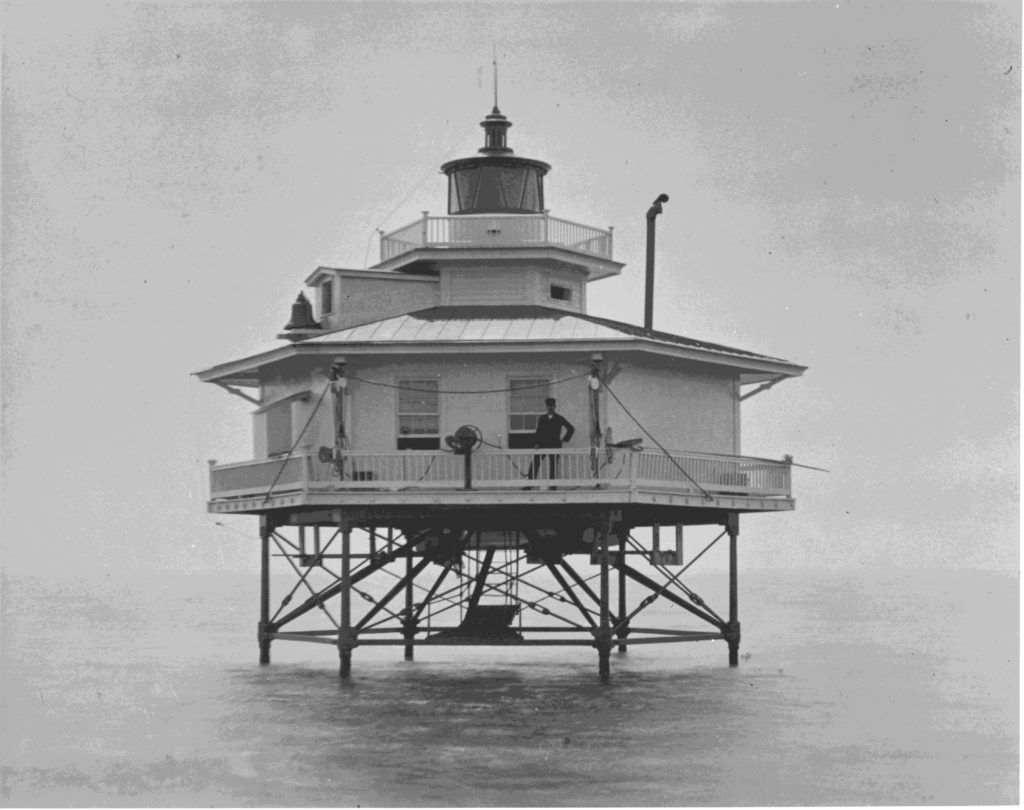Early in the morning of July 15, 1861, a watch officer aboard a Union ship exploring the Rappahannock River spotted a group of men in Stingray Point lighthouse, their boat unmoored and drifting. Assuming there had been a mishap, the screw steamer Mount Vernon sent an armed cutter to investigate. What they found there helped shaped the way the Civil War was fought, and informed the way the U.S. military forces accepted Black Americans who managed to escape bondage, eager to fight for their own freedom and the emancipation of those they left behind.
The cutter picked up six young men at the lighthouse, according to contemporary accounts: brothers Samuel, John, Miles, and Peter Hunter; David Harris; and Alexander Franklin. The six had escaped enslavement and forced service in the Confederate Army and made their way to the abandoned lighthouse, knowing that Federal forces had blockaded the entrance to the Bay. If they returned, or were returned, to Virginia, the men faced death at the hands of the Confederates.
A road sign honoring their bravery, and their later contributions to the war and the cause of emancipation, was erected last year in Deltaville, Va. The marker’s sponsor is the Middle Peninsula African-American Genealogical and Historical Society (Middle Peninsula AAGHS). President of Middle Peninsula AAGHS Bessida Cauthorne White said at the unveiling that the group learned in 2019 that only about 12 percent of Virginia’s Historic roadside makers related to African-Americans. Her group—which included Davaline Taliaferro, a great-granddaughter of David Harris—vowed to change that.
“We decided to take action and we found it was not at all difficult to identify topics deserving of a marker,” says White. “We started with Stingray Point Lighthouse simply because much of the heavy lifting in terms of research had been done by our member Davaline Taliaferro. So many years ago, Davaline shared the story with us.” Her ancestor David Harris was the only one of the formerly enslaved men known to have returned to the area after the Civil War. He lived in the Amburg area, in what is today Deltaville.
After the rescue at Stingray Point, the debate by Naval officials over what to do with the six escaped men had ramifications beyond their own fates. It encouraged the Navy’s wartime commitment that runaway enslaved were, in fact, “contraband of war” and would not be returned to their owners. The contraband theory had been established earlier that year by Union General B.F. Butler at Fort Monroe. General Butler refused to return a group of enslaved freedom seekers to their enslaver in May of 1861, declaring them instead as “contraband of war.” Although President Lincoln discouraged this because he feared it would encourage border states to join the Confederacy, the U.S. Congress supported Butler’s move and passed the first Confiscation Act in August of 1861. This paved the way for enslaved Blacks to enlist in the Union Navy, and later the Army, playing a significant role in fighting for and winning their freedom.
All six of the men liberated at Stingray Point would end up enlisting in the U.S. Navy after their rescue. Harris enlisted in the Union Navy on board the U.S.S. Minnesota in Hampton Roads on September 16, 1861, and was later transferred to U.S.S. William Badger, where he served as a cook. He was honorably discharged from the Navy. After the war, he filed for a Union pension and was awarded $6 a month. After his death, his widow received $12 a month.
The six refugees at Stingray Point were soon followed by others—three more men came aboard the Mount Vernon within days—and all brought valuable intelligence about the state of things ashore to the ship’s Commander Oliver S. Glisson.
The enslaved men informed Glisson that free Black Virginians in Middlesex County had been forced to work on batteries about to be erected in different parts of the state. All the poor white men were drafted into the service of the rebels, while the rich men took command.
“It was their intention to put muskets in the hands of the negroes, and in case of an attack … made by any armed vessels the slaves were to form the advance guard and otherwise cover the white chivalry,” Glisson wrote in a letter to his commanding officer. “This the Negros did not appear to relish and contrary to advice and threats, they deliberately left their homes about 2 a.m. on Monday morning, and depositing themselves in a canoe, made for the lighthouse.”

One-hundred and sixty years after their daring escape, the men were honored at an unveiling ceremony for the roadside marker bearing their tale. More than 100 people attended the dedication, including Davaline Taliaferro, whose research kickstarted the efforts, along with two of David Harris’s other great-granddaughters, Darlene Harris Roye and Ceres Brooks. White, of the AAGHS, poured libations and gave a dedication:
“May the indomitable spirit of those named and unnamed engulf this occasion. We offer thanks to this glorious crowd of witnesses whose ancestors had courage and fortitude in facing overwhelming adversity that led us to this day of commemoration and dedication.”



